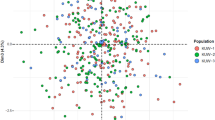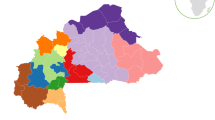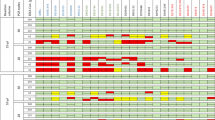Abstract
Disaster victim identification traditionally relies on the combined efforts of police, dentists and pathologists, comparing ante mortem (AM) information from the missing persons with post mortem (PM) data from the dead bodies. In Western countries, dental evidence has ordinarily played the major role1–3. DNA analysis has been used successfully in a number of large accidents to associate body parts and for purposes of identification, by comparing victims' DNA profiles with those of relatives 4–6. However, DNA typing is still not generally regarded as an essential part of disaster victim identification. Facing the August 1996 Spitsbergen aircraft accident in which 141 Russians and Ukrainians died and anticipating scanty ante mortem dental data, it was decided to use DNA profile analysis as the primary identification method. Material collected at the scene from all body parts, and blood samples from relatives were analysed at eight polymorphic microsatellite and minisatellite loci. DNA profile comparisons enabled us to sort the 257 typed body parts into 141 individuals, as well as identifying the 139 victims for whom reference samples were available. Identification by DNA analysis was then followed by comparisons of traditional AM and PM data, and within day 20 of the accident the identities of all victims were confidently established . This investigation indicates that it might be feasible to replace traditional identification efforts with DNA typing.
This is a preview of subscription content, access via your institution
Access options
Subscribe to this journal
Receive 12 print issues and online access
$209.00 per year
only $17.42 per issue
Buy this article
- Purchase on Springer Link
- Instant access to full article PDF
Prices may be subject to local taxes which are calculated during checkout
Similar content being viewed by others
References
Clark, D.H. An analysis of the value of forensic odontology in ten mass disasters. Int. Dent. J. 44, 241–250 (1994).
Moody, G.H. & Busuttil, A. Identification in the Lockerbie disaster. Am. J. Forensic Med. Path. 15, 63–69 (1994).
Solheim, T., Lorentsen, M., Sundnes, P.K., Bang, G. & Bremnes, L. The “Scandinavian Star” ferry disaster 1990- a challenge to forensic odontology. Int. J. Legal Med. 104, 339–345 (1992).
Clayton, T.M., Whitaker, J.P. & Maguire, C.N. Identification of bodies from the scene of a mass disaster using DNA amplification of short tandem repeat (STR) loci. Forensic Sci. Int. 76, 7–15 (1995).
Ludes, B. et al. Medico-legal investigations of the Airbus, A320 crash upon Mount Ste-Odile. J. Forensic Sci. 39, 1147–1152 (1994).
Corach, D., Sala, A., Penacino, G. & Sotelo, A. Mass disasters: rapid molecular screening of human remains by means of short tandem repeats typing. Electrophoresis 9, 1617–1623 (1995).
Fisher, R.A. Standard calculations for evaluating blood group systems. Heredity 5, 95–102 (1951).
Dupuy, B.M. & Olaisen, B. Corresponding repeats in STRs and the internal standard in fragment analysis. In Advances in Forensic Haemogenetics 6 (eds Carracedo, A., Brinkmann, B. & Bär, W.) 127–129 (Springer-Verlag, Berlin Heidelberg, 1996).
Akana, A. et al. Sex identification of forensic specimens by polymerase chain reaction (PCR): two alternative methods. Forensic Sci. Int. 49, 81–88 (1991).
Jeffreys, A.J., Royle, N.J., Wilson, V. & Wong, Z. Spontaneous mutation rates to new length alleles at tandem-repetitive hypervariable loci in human DNA. Nature 332, 278–281 (1988).
Olaisen, B., Bekkemoen, M., Hoff-Olsen, P. & Gill, P. Human VNTR mutation and sex. In DNA-Fingerprinting: State of the science (eds. Pena, S.D.J., Chakraborty, R., Epplen, J.T. & Jeffreys, A.J.) 63–69 (Birkhauser Verlag, Basel, 1993).
Gill, P. et al. Identification of the remains of the Romanov family by DNA analysis. Nature Genet. 6, 130–135 (1994).
Jeffreys, A.J., Brookfield, J.F.Y. & Semeonoff, R. Positive identification of an immigration test-case using human DNA fingerprints. Nature 317, 818–819 (1985).
Whitaker, J.P. et al. Short tandem repeat typing of bodies from a mass disaster: high success rate and characteristic amplification patterns in highly degraded samples. Biotechniques 18, 670–677 (1995).
Kimpton, C.P. et al. Evaluation of an automated DNA profiling system employing multiplex amplification of four tetrameric STR loci. Int. J. Leg. Med. 106, 302–311 (1994).
Kimpton, C.P. et al. Validation of highly discriminating multiplex short tandem repeat amplification systems for individual identification. Electrophoresis 17, 1283–1293 (1996).
Gilchrist, J., Lockerbie air disaster. Interpol Internatl. Criminal Police Rev. 497-498, 23–28 (1992).
Miller, S.A. A simple salting-out procedure for extracting DNA from human nucleated cells. Nucl. Acid Res. 16, 1215 (1988).
Schneider, P.M. et al. Report of an European collaborative exercise comparing DNA typing results using a single locus DNA probe. Forensic Sci Int. 49, 1–15 (1991).
Mostad, P.P. & Egeland, T. Probability assessments of family relations using the program “pater”. NR-note SAND/6/96, Norwegian Computing Center, (1996).
Elston, R. & Stewart, J. A general model for the genetic analysis of pedigree data. Hum. Heredity 21, 523–534, (1971).
Author information
Authors and Affiliations
Corresponding author
Rights and permissions
About this article
Cite this article
Olaisen, B., Stenersen, M. & Mevåg, B. Identification by DNA analysis of the victims of the August 1996 Spitsbergen civil aircraft disaster. Nat Genet 15, 402–405 (1997). https://doi.org/10.1038/ng0497-402
Received:
Accepted:
Issue Date:
DOI: https://doi.org/10.1038/ng0497-402
This article is cited by
-
Improved Y-STR typing for disaster victim identification, missing persons investigations, and historical human skeletal remains
International Journal of Legal Medicine (2018)
-
Application of permanents of square matrices for DNA identification in multiple-fatality cases
BMC Genetics (2013)
-
Integrating forensic anthropology into disaster victim identification
Forensic Science, Medicine, and Pathology (2012)
-
DNA analysis in disaster victim identification
Forensic Science, Medicine, and Pathology (2012)
-
Use of prior odds for missing persons identifications
Investigative Genetics (2011)



